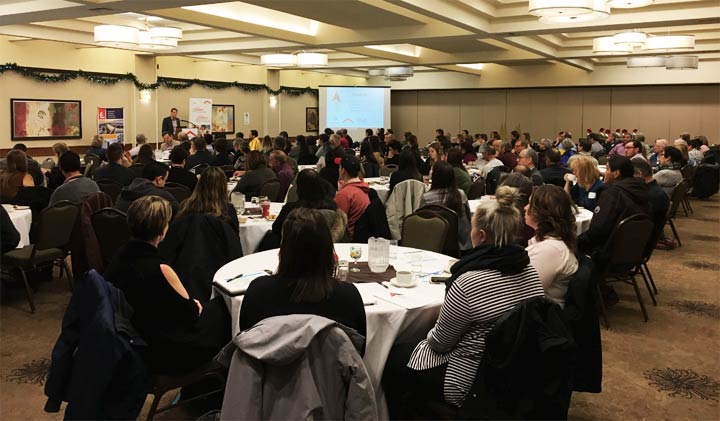Community groups and organizations gathered Wednesday to discuss what’s being done to tackle homelessness and affordable housing in Saskatoon.

The conference is put on by the City of Saskatoon, Saskatchewan Housing Corporation, the Saskatchewan Housing Initiatives Partnership (SHIP) and the Canada Mortgage and Housing Corporation (CMHC) planning committee.
“It’s really an opportunity for people to come together, talk, network and build collaborative relationships,” SHIP executive director Shaun Dyck said. “The only way that we’re going to address homelessness is if we work together.”
The province-wide conference was held in conjunction with national housing day in Canada, with discussions around innovative approaches to training, homelessness initiatives across the country and affordable housing.
“That really is the crux of the issue for people experiencing homelessness,” Dyck said. “We see a lot of people that don’t have money through income support or even working day to day at minimum wage; it’s too expensive to afford decent, safe and accessible housing for those who need it.”
The main focus of this year’s conference is Indigenous issues and homelessness. According to SHIP, Indigenous people in Saskatoon face a higher rate of both homelessness and housing insecurity.
“It’s building that safe space for all of us, all of us as Canadians going forth,” Sidney Gill of the Calgary Aboriginal Friendship Centre, said. “Not just us Indigenous, non-Indigenous, newcomers; we all know Canada as the melting pot that it is, so we need to move forward as one.”
He is also one of the keynote speakers at the conference. Gill said he fell into drugs and alcohol at a young age, spending between the ages of 16 and 26 inside institutions and jail.
He turned his life around and pursued a career in social work, after helping implement a Pathways Program in jail for Indigenous men who wanted to live their culture despite being behind bars.
In his presentation to those in attendance, he outlined the link between separation from culture and Indigenous homelessness due to the impacts of colonization and residential schools.
“It means more than four walls and roof over your head, it means having that connection to the land, having that connection to each other,” Gill said.
“Having that built into a house and having that culture piece is what really rounds out a home for me; but not everyone will want that in their house too, some folks will just want to live like normal Canadians.”
The most recent count shows there are around 450 people who are homeless in Saskatoon. According to Dyck, 808 homeless people, including 283 children the city have been housed and supported since 2014 through various initiatives and partnerships.
On national housing day, the federal government announced its plan to help families find an affordable place to live. The national housing strategy includes $40 billion over the next 10 years for housing benefits to low-income tenants, the construction of 80,000 affordable rental units and repairs and renovations to 300,000 existing units.
SHIP is welcoming the investment, saying it will make a substantive difference in helping people find safe and affordable housing.
“Appropriate, affordable and safe housing is the starting point of stability for all of us,” SHIP president Jessica Kyle said in a statement.
“A major investment and a succinct vision in Canada was long overdue. The national housing strategy takes us in the right direction. The concept that Canadians have a ‘right to housing’ sets the tone moving forward. It’s humane. It’s the right thing to do.”
“The Canada Housing Benefit will have a huge impact on actually preventing homelessness and will substantially reduce the number of people in core housing need,” Dyck said in a statement. “We see this as an important piece of the puzzle, as affordability is sometimes the only barrier to secure housing.”
The majority of the federal funding won’t come until after the next election.



Comments